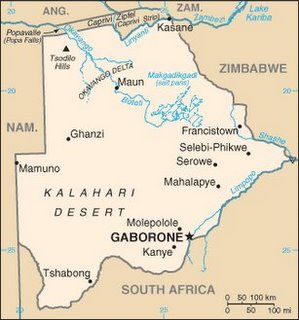I will be traveling east and into Botswana as we attend this years annual ITS user group conference. The conference is it to be held at the Gaborone Conference Centre. We will be meeting with other institutions throughout the world that use the ITS enterprise wide education management software. I look forward to brushing shoulders with people from South Africa, Botswana, Mozambique, Zambia, Zimbabwe, Ireland and possibly Bolivia.
We are staying at the Grand Palms Hotel Gaborone. There are lectures and workshops planned for most of the day but the nights are rumored to be great fun. I look forward to sharing my photos late next week. I shall return Thursday March 16, 2005.


Botswana, one of Africa’s most stable countries, is the continent’s longest continuous multi-party democracy. It is relatively free of corruption and has a good human rights record.
It is also the world’s largest producer of diamonds and the trade has transformed it into a middle-income nation.
Botswana protects some of Africa’s largest areas of wilderness. It is sparsely populated, because it is so dry. The Kalahari desert, home to a dwindling band of Bushman hunter-gatherers, makes up much of the territory and most areas are too arid to sustain any agriculture other than cattle.
Politics
The government wants the remaining Bushman population of the Kalahari game reserve to move to nearby towns. It denies reports that some Bushmen have been forced off their ancestral land.
In the late 1800s Britain formed the protectorate of Bechuanaland, preventing territorial encroachment of Boers from the Transvaal or German expansion from South West Africa. In 1966 Bechuanaland became independent as Botswana.
Botswana was a haven for refugees and anti-apartheid activists from South Africa in the 1970s and 1980s, but had to tread carefully because of its economic dependence on the white-ruled neighbour, and because of South Africa’s military might.
More recently, the country has seen an influx of illegal immigrants seeking respite from the economic crisis in neighbouring Zimbabwe.
Botswana, which once had the world’s highest rate of HIV-Aids infection, has one of Africa’s most-advanced treatment programmes. Anti-retroviral drugs are readily available.
However, the UN says more than one in three adults in Botswana are infected with HIV or have developed Aids. The disease has orphaned many thousands of children and has dramatically cut life expectancy.
Botswana is trying to reduce its economic dependence on diamonds. Safari-based tourism – tightly-controlled and often upmarket – is an important source of income.
Quick Facts
* Population: 1.8 million (UN, 2005)
* Capital: Gaborone
* Area: 581,730 sq km (224,607 sq miles)
* Major languages: English (official), Setswana
* Major religions: Christianity, indigenous beliefs
* Life expectancy: 36 years (men), 37 years (women) (UN)
* Monetary unit: 1 Pula = 100 thebe
* Main exports: Diamonds, copper, nickel, beef
* GNI per capita: US $4,340 (World Bank, 2005)
* Internet domain: .bw
* International dialling code: +267
Source: BBC


Like this:
Like Loading...
Michael Paskevicius
Share post:
I will be traveling east and into Botswana as we attend this years annual ITS user group conference. The conference is it to be held at the Gaborone Conference Centre. We will be meeting with other institutions throughout the world that use the ITS enterprise wide education management software. I look forward to brushing shoulders with people from South Africa, Botswana, Mozambique, Zambia, Zimbabwe, Ireland and possibly Bolivia.
We are staying at the Grand Palms Hotel Gaborone. There are lectures and workshops planned for most of the day but the nights are rumored to be great fun. I look forward to sharing my photos late next week. I shall return Thursday March 16, 2005.
Botswana, one of Africa’s most stable countries, is the continent’s longest continuous multi-party democracy. It is relatively free of corruption and has a good human rights record.
It is also the world’s largest producer of diamonds and the trade has transformed it into a middle-income nation.
Botswana protects some of Africa’s largest areas of wilderness. It is sparsely populated, because it is so dry. The Kalahari desert, home to a dwindling band of Bushman hunter-gatherers, makes up much of the territory and most areas are too arid to sustain any agriculture other than cattle.
Politics
The government wants the remaining Bushman population of the Kalahari game reserve to move to nearby towns. It denies reports that some Bushmen have been forced off their ancestral land.
In the late 1800s Britain formed the protectorate of Bechuanaland, preventing territorial encroachment of Boers from the Transvaal or German expansion from South West Africa. In 1966 Bechuanaland became independent as Botswana.
Botswana was a haven for refugees and anti-apartheid activists from South Africa in the 1970s and 1980s, but had to tread carefully because of its economic dependence on the white-ruled neighbour, and because of South Africa’s military might.
More recently, the country has seen an influx of illegal immigrants seeking respite from the economic crisis in neighbouring Zimbabwe.
Botswana, which once had the world’s highest rate of HIV-Aids infection, has one of Africa’s most-advanced treatment programmes. Anti-retroviral drugs are readily available.
However, the UN says more than one in three adults in Botswana are infected with HIV or have developed Aids. The disease has orphaned many thousands of children and has dramatically cut life expectancy.
Botswana is trying to reduce its economic dependence on diamonds. Safari-based tourism – tightly-controlled and often upmarket – is an important source of income.
Quick Facts
* Population: 1.8 million (UN, 2005)
* Capital: Gaborone
* Area: 581,730 sq km (224,607 sq miles)
* Major languages: English (official), Setswana
* Major religions: Christianity, indigenous beliefs
* Life expectancy: 36 years (men), 37 years (women) (UN)
* Monetary unit: 1 Pula = 100 thebe
* Main exports: Diamonds, copper, nickel, beef
* GNI per capita: US $4,340 (World Bank, 2005)
* Internet domain: .bw
* International dialling code: +267
Source: BBC


Share this:
Like this: